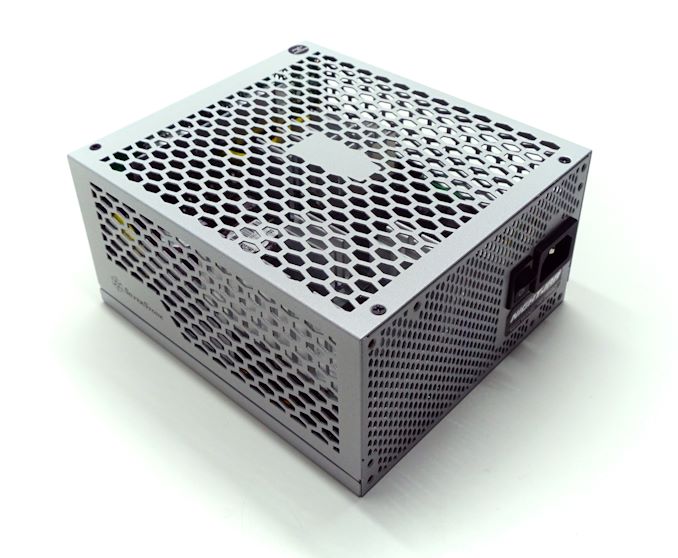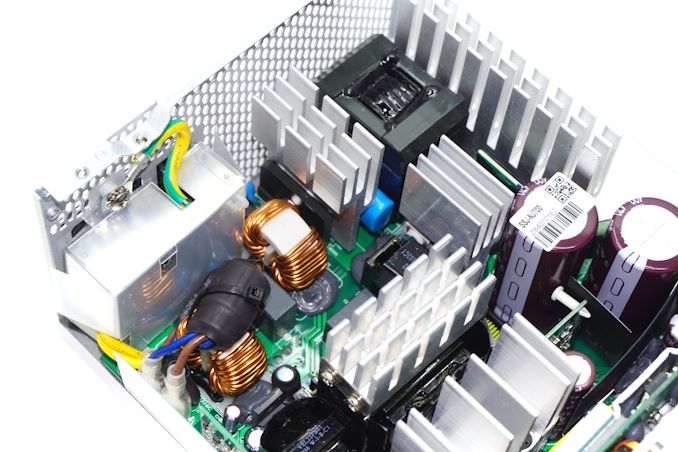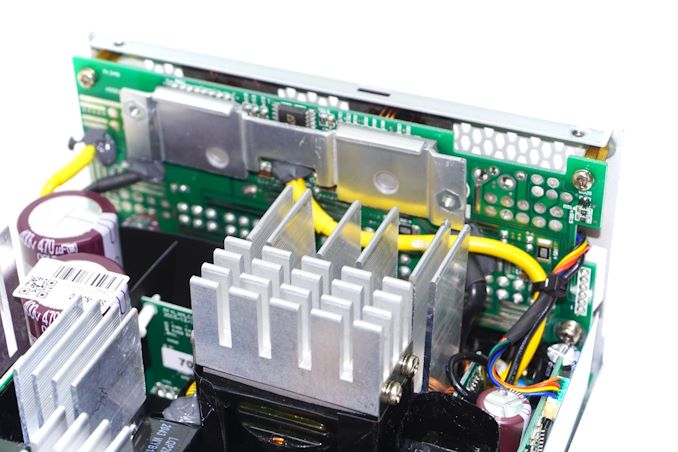The SilverStone NightJar NJ700 Passive PSU Review: Silent Excellence
by E. Fylladitakis on November 29, 2021 8:00 AM EST- Posted in
- Cases/Cooling/PSUs
- PSUs
- SilverStone
- Passive Cooling
Power Supply Quality
As part of our testing, we also check output parameters are within specifications, as well as voltage ripple and line noise.
| Main Output | ||||||||
| Load (Watts) | 141.38 W | 352.97 W | 528.19 W | 703.06 W | ||||
| Load (Percent) | 20.2% | 50.42% | 75.46% | 100.44% | ||||
| Amperes | Volts | Amperes | Volts | Amperes | Volts | Amperes | Volts | |
| 3.3 V | 1.8 | 3.41 | 4.49 | 3.41 | 6.74 | 3.4 | 8.99 | 3.39 |
| 5 V | 1.8 | 5.09 | 4.49 | 5.09 | 6.74 | 5.08 | 8.99 | 5.07 |
| 12 V | 10.42 | 12.1 | 26.06 | 12.08 | 39.09 | 12.05 | 52.12 | 12.03 |
| Line | Regulation (20% to 100% load) |
Voltage Ripple (mV) | |||||
| 20% Load | 50% Load | 75% Load | 100% Load | CL1 12V |
CL2 3.3V + 5V |
||
| 3.3V | 0.75% | 12 | 12 | 14 | 16 | 14 | 12 |
| 5V | 0.5% | 8 | 8 | 10 | 16 | 8 | 12 |
| 12V | 0.6% | 6 | 8 | 8 | 12 | 8 | 12 |
The power quality figures that we received while testing the SilverStone NJ700 inside our hotbox were astounding. We recorded a maximum voltage ripple of 12 mV on the 12V line at 100% load, an incredible power quality figure by any comparison. Voltage regulation also is very tight on the 12V line, staying lower than 0.6% across the nominal output range. The secondary 3.3V and 5V rails are a bit less well filtered, with the voltage ripple reaching 16 mV on both rails under maximum load. Otherwise, the secondary lines are just as tightly regulated, at around 0.5% for both the 3.3V and 5V rails.
Conclusion
SilverStone is greatly focused on the development of high-performance living room entertainment PCs, which goes in tandem with the marketing of ultra-quiet PSUs. The Nightjar NJ700 is a statement product designed both to lure in enthusiasts that will not mind the hefty price tag and to outdo the company’s main competitors.
The OEM behind the Nightjar NJ700 is SeaSonic, perhaps the most reputable top-tier PC PSU OEM. On top of that, the NJ700 is based on what is currently SeaSonic’s best platform. We found only top-tier components inside the Nightjar NJ700, ranging from critical parts down to insignificant filtering capacitors. The developer of this PSU spared no expense and that showed during our testing, when the Nightjar NJ700, a PSU that lacks any form of active cooling, was operating unaffected inside our hotbox and with virtually no change in its performance. SilverStone covers the Nightjar NJ700 with a five-year warranty, which is sufficient, yet strange when the OEM markets the same platform with a 12-year warranty.
Although the platform that the Nightjar NJ700 is analog and relatively basic by today’s standards, the designer of this PSU managed to get ridiculous performance figures out of it. The Nightjar NJ700 comes with an 80Plus Titanium certification tag and it honors it, delivering exceptionally high energy conversion efficiency even when the load is very low. Efficiency is not the only thing that the NJ700 excels on, as its power quality figures also are astounding. Despite its lack of active cooling, heat has practically no effect on the unit’s electrical performance either. All in all, the overall performance of the Nightjar NJ700 is world-class.
With all of that said, when using a passively cooled PSU, there are certain implications that need to be considered. The major point that is the fact that the thermal losses of the PSU will be released inside the system itself, whereas typical, active-cooled PSUs would exhaust most of that thermal energy to the outside of the case. This means that the system itself will get hotter and may require better cooling in order to sustain its overall performance. In this case, the high power output of the NJ700 translates to significant thermal losses when the unit is heavily loaded – regardless of its very high efficiency, there will be more than 35 Watts of thermal energy released to the environment. This will probably not be a problem with modern systems that are built with efficiency in mind, but the specifics of this must be considered and weighted by the system’s builder. After all, it would not make any sense to use a passively cooled PSU only to replace it by another noise source, such as additional case fans.
SilverStone’s choice to market the Nightjar NJ700 could not have been easy. On one hand, the nature of the product aligns with the company profile and their efforts to develop top-performance living room gaming systems. On the other hand, SilverStone has to compete with the OEM of the NJ700, the legendary SeaSonic, as they also market the same platform under their own brand. Practically no other company offers direct competition to the passively cooled NJ700 right now, meaning that its success largely depends on how well its $308 retail price and overall availability fare in comparison to SeaSonic’s Prime Fanless TX-700. That, in conjunction with the strangely significantly shorter warranty length, can be a very complicated subject for SilverStone’s marketing department.













46 Comments
View All Comments
Wrs - Saturday, December 11, 2021 - link
Noise cancelation is already used in aviation headsets - realize it does cost something and sometimes a cheap pair of earplugs is more than sufficient. Those subway researchers didn't miss anything, they just wanted to point out the amount of noise. It's on subway riders to get earplugs or cheap passive headphones if they can't afford ANC, or learn to steady eardrums with a reverse valsalva. Typically 75dB is regarded as starting to cause hearing loss. That's 1000 times as intense as a somewhat noisy 45dB machine.Decibels are simply a log base 10 scale. If you raise the intensity by 5x, that's a 7dB gain. So 5 35dB fans that don't attenuate each other, 42dB. Every 2x is 3dB, 4x is 6dB, hope you get the picture.
Sorry about your experience with Beats. Ive never tried them but wouldn't associate them with good value. Bose is generally the ANC standard. Apple's Airpods Pro and Max are also well regarded. I use a Max and though a hiss is impossible to negate entirely its kind of hard for me to even notice it. Unfortunately I do not know how the experience differs for someone with significant tinnitus (everyone has that ringing, it just varies to what degree).
Wrs - Saturday, December 11, 2021 - link
So the comments about PSU sometimes adding insignificant noise are practically true. If the rest of system is already at 40dB when the PSU tops out at 29dB, they're not moving to 41dB. And all of this is nowhere close to causing hearing loss.Oxford Guy - Friday, December 24, 2021 - link
And the Seasonic ‘Snow Silent’ PSU that ‘could be heard from rooms away’?That’s a quote from the review here.
Wrs - Saturday, December 25, 2021 - link
I can't find a Snow Silent review from AT, but I did find a rather competent one done in 2015 by Tom's, where it was found relatively quiet to 50% but measured 52dB 1m away at 80%+ load, which I suppose is audible from rooms away (it depends on the frequency distribution). Perhaps half the name was a misnomer.Then in 2016 the same author reviewed a Prime Titanium 850W that stayed under 30dB until almost 800W. That's two orders of magnitude less sound energy.
TheinsanegamerN - Tuesday, November 30, 2021 - link
The last PSU that I owned, that was audible at all under load, was an old diablotek power suppyl with two 80 MM fans. Most moderen 120mm PSUs run cool enough and quiet enough that absent a totally silent system will be inaudible.Oxford Guy - Thursday, December 2, 2021 - link
Many modern PSUs are audible. One of them, a Seasonic ‘Snow Silent’ model could be ‘heard from rooms away.’That is a direct quote from the Anandtech review.
alcoholbob - Saturday, December 4, 2021 - link
Both the TX-700 (which the NJ700 is based on) and the NJ700 had problems with audible coil whine even while idling, which were much worse than higher wattage Seasonic semi-fanless units while running fanlessly. The issue with these 700W models appears to be the fact that the coil whine is very high pitched, so its quite audible from several feet away.On higher wattage Seasonic units like the 850W or 1000W RMx series, there is coil whine but its much lower in frequency. Due to the Fletcher Munson effect, it sounds nearly inaudible, while the TX-700 and NJ700, as well as lower end 520W and 420W Nightjar models sound to me quite unbearably loud due to the high frequency nature of the whine.
I find it much cheaper to simply get a Corsair RMx unit and just mod the fan with a low noise Noctua fan.
Oxford Guy - Friday, December 24, 2021 - link
I recall that it was fan noise not coil whine that made that PSU audible, according to the reviewer.ruthan - Thursday, December 2, 2021 - link
Im only missing 2x EPS cable for some dual socket builds, 700W is enough for them.I had fanless Seasonic and Silverstones, in the past.. My expecience is than Silverstone have better cooling, it worked in machine, where Seasonic with same Wattage was overheating.
But we need some head to head review.
albaikinindia - Monday, December 6, 2021 - link
thanks for share this information keep your post update with new content. https://www.al-baik.in/